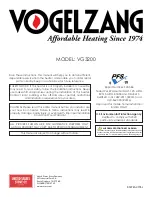
508096-01
Issue 2037
Page 23 of 34
In case emergency shutdown is required, turn off the
main shut-off valve and disconnect the main power to
unit. These controls should be properly labeled by the
installer.
IMPORTANT
Do not over torque (800 in-lbs) or under torque (350
in-lbs) when attaching the gas piping to the gas valve.
WARNING
When pressure testing gas lines, the gas valve must be
disconnected and isolated. Gas valves can be damaged if
subjected to more than 0.5psig (14” W.C.). See Figure 18.
If the pressure is equal to or less than 0.5psig (14”W.C.),
close the manual shut-off valve before pressure testing to
isolate furnace from gas supply.
Figure 18. Gas Piping Test Procedure
MANUAL MAIN SHUT-OFF VALVE
WILL NOT HOLD TEST PRESSURE
IN EXCESS OF 0.5 PSIG (14”W.C.)
GAS VALVE
CAP
FIELD PROVIDED
LINE PRESSURE TAP
When checking piping connections for gas leaks, use
preferred means. Kitchen detergents can cause harmful
corrosion on various metals used in gas piping. Use of a
specialty Gas Leak Detector is strongly recommended.
Do not use matches, candles, flame or any other source
of ignition to check for gas leaks.
WARNING
Gas Pressure Adjustment
Gas Flow (Approximate)
Furnace should operate at least 5 minutes before checking
gas flow. Determine time in seconds for two revolutions of
gas through the meter. (Two revolutions assures a more
accurate time.) Divide by two and compare to time in
Table 8. If manifold pressure matches Table 10 and rate is
incorrect, check gas orifices for proper size and restriction.
Remove temporary gas meter if installed.
NOTE:
To obtain accurate reading, shut off all other gas
appliances connected to meter.
Capacity
Seconds for One Revolution
Natural
LP
1 cu ft
Dial
2 cu ft
Dial
1 cu ft
Dial
2 cu ft
Dial
-45
80
160
200
400
-70
55
110
136
272
-90
41
82
102
204
-110
33
66
82
164
-135
27
54
68
136
Natural-1000 btu/cu ft LP-2500 btu/cu ft
Table 8. Gas Meter Clocking Chart
Supply and Manifold Pressure
Supply Pressure Measurement
1.
Remove the threaded plug from the inlet side of the
gas valve and install a field-provided barbed fitting.
Connect to a test gauge to measure supply pressure.
2.
Start unit and allow 5 minutes for unit to reach steady
state.
3.
After allowing unit to stabilize for 5 minutes, record
supply pressure and compare to value given in Table
Manifold Pressure Measurement
1.
Remove the threaded plug from the outlet side of the
gas valve and install a field-provided barbed fitting.
Connect to a test gauge to measure manifold pressure.
2.
Start unit and allow 5 minutes for unit to reach steady
state.
3.
While waiting for the unit to stabilize, observe the
flame. Flame should be stable and should not lift from
burner. Natural gas should burn blue.
4.
After allowing unit to stabilize for 5 minutes, record
manifold pressure and compare to value given in
NOTE:
Shut unit off and remove manometer as soon as an
accurate reading has been obtained. Take care to remove
barbed fitting and replace threaded plug.












































